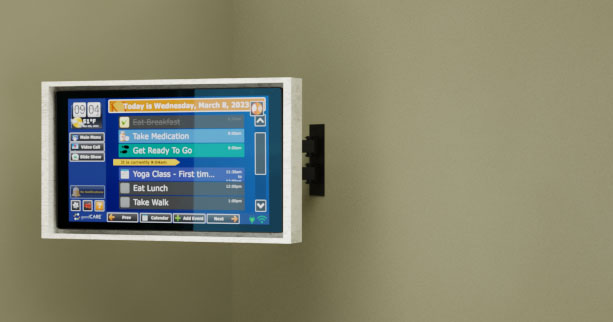Intel/GE recognizes the HUGE importance of linking socialization to remote monitoring…we’re obviously on the right track!!!!
This is great news, seeing the big giants like GE & Intel embracing and realizing the value of socialization, reminders and cognition (being equally important to the wellness & ADL monitoring). QuietCare was bleeding edge, I would venture to say they were the first ones to really get out there with their Activity of Daily Living remote monitoring system back in 2005. GrandCare & HealthSense were not far behind. The three of us watched each other, paved roads for one another and learned from each other. I am so glad that QuietCare is being used in this venture, it really is a great system. GrandCare founder, Charlie Hillman, was so visionary back in 2005 – being the first to combine socialization/cognition along with ADL monitoring into one system. Funny thing is, even I (at the time) didn’t “get it” – didn’t see why it would be so important to have that “GrandCare Communication Station”, which of course has turned into the interactive touchscreen/video chat… Think of how far we all have come since 2005, especially with all of the new players in this market and the new focus to the digital home health field. I see great things happening every day in this industry and look forward to what the future will bring…
Take a look at Laurie Orlov’s blog entry on this:
Care Innovations Connect Makes Telehealth Social
Submitted by Laurie Orlov on Wed, 07/20/2011 – 09:49
http://www.ageinplacetech.com/blog/care-innovations-connect-makes-telehealth-social
Care Innovations — tackling social isolation and wellness. In some ways, yesterday’s launch of Connect from Intel-GE’s wholly owned Care Innovationjoint venture should come as no surprise. When the companies combined last year, spun out of Intel’s Digital Health group and GE’s QuietCare business units, I was hopeful that they would transcend limitations of the previous parents. Especially given Intel’s investment history of researching social needs of seniors, Omar Ishrak’s comment last August really resonated: “We recognize that the conditions faced by home health patients are not necessarily clinical. It is part of our core mission [in the Joint Venture] to address social and support needs.”
Beyond patient to the person behind the monitoring. A touch-screen device placed in the home enables a senior to have access to social networks, customized content, news, and also wellness surveys that are typical of telehealth devices – which historically have been useful for health providers, proven beneficial to seniors with chronic disease (reducing those dreaded re-hospitalizations). But fun, social, two-way experiences, as much about enabling a senior to see out as well as caregivers see in? When the person is viewed as a patient, that can’t happen. Care Innovations’ Connect targets the person (and patient to a lesser degree) in a device paradigm that, for now, can be useful to frail seniors. When I chatted with him a few days ago, Care Innovations GM James Pursley did not rule out the possibility that future versions may take advantage of growing tablet mania – placing Connect as a starting point in the evolution of technologies that will connect caregivers, providers, and seniors together – as it must be.
Tech platforms are transitory – vendors must pick a platform for now. We are in yet another platform shift today – recognizing that a relatively small percentage of the frailest seniors are comfortable with computers or have high-speed data plans, for that matter, so dedicated appliance solutions make sense during the transition – Sonamba’s Wellbeing Monitor uses a picture frame paradigm to provide similar social connection functionality as Connect. Other vendors, including Independa’s recently launched Angela targets the same market by customizing software into an ‘off-the-shelf’ tablet that also enables video chat.
Despite tech paradigms shift, products must launch. In some ways, it is a particularly murky and complex time to be launching technologies in this market. Complicated channel strategies must parse a fragmented prospective audience –healthcare? Senior housing? How to reach families? What about home security and electronics dealers – are they vested and interested in this space? Can they reach the last few feet into the home? Today’s PERS pendant/service (a market that’s been around FOREVER) may migrate right onto a smartphone, Telehealth devices may migrate to tablets (Dell thinks so and doctors ‘embrace’ the iPad), and there’s the television, sitting not so quietly in the corner of every senior’s living room – maybe a future social engagement device that is (comparatively speaking) designed for all. Designing for all (including the loneliest seniors in nursing homes or their own homes) is what vendors must do. Emerging markets reflect flux in both user willingness, channel interest, and market readiness. Let’s applaud Care Innovations – and its Intel/GE backers! They validate and verify the value this market brings to the lives of older adults.



